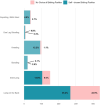Birthing positions and mother`s satisfaction with childbirth: a cross-sectional study on the relevance of self determination
- PMID: 39495292
- PMCID: PMC11919968
- DOI: 10.1007/s00404-024-07770-1
Birthing positions and mother`s satisfaction with childbirth: a cross-sectional study on the relevance of self determination
Abstract
Introduction: Considering the inconclusive evidence regarding the clinical benefits of specific birthing positions, emphasis has been placed on adhering to women's preferences during the second stage of labour. Therefore, the present study aimed to assess the association between birthing position, the freedom to choose a birth position during the second stage of labour, and women's subjective satisfaction with childbirth.
Methods: We performed a cross-sectional survey of women 8 or 12 months after a vaginal birth in a hospital. The women were recruited via two cooperating health insurance companies. Multivariate analyses were conducted to assess the strength of the association between birthing position and maternal satisfaction with childbirth, with a particular focus on interactions with self-determination.
Results: In total, the data from 761 women were analysed. The supine position was the most frequently reported birthing position in the second stage of labour at 77.5%. Notably, 39.0% and 30.5% of the women who gave birth in the dorsal and lateral supine positions, respectively, stated that the birth position was not chosen voluntarily. The regression models show a significant negative association between supine birthing position and satisfaction with childbirth, which is significantly related to self-determination. The most common reason for the adoption of a specific birthing position was instructions from medical staff.
Discussion: The data provide insight into the perceived satisfaction with childbirth depending on the birthing position, whereby the relevance of self-determination is particularly evident. At the same time, self-determination is often not given, which is associated with reduced birth satisfaction.
Keywords: Birth setting; Birthing position; Labor; Parturition; Satisfaction with childbirth; Vaginal birth.
© 2024. The Author(s).
Conflict of interest statement
Declarations. Conflict of interest: The authors have no relevant financial or non-financial interests to disclose. Ethical approval: The Ethics Committee of the Medical Faculty of the University of Cologne approved the study (22-1260). Consent to participate: Implicit informed consent was obtained from all individual participants included in the study.
Figures
References
-
- Alfirevic Z, Devane D, Gyte GM et al (2017) Continuous cardiotocography (CTG) as a form of electronic fetal monitoring (EFM) for fetal assessment during labour. Cochrane Database Syst Rev. 10.1002/14651858.CD006066.pub3 - PubMed
-
- Alruwaili TA, Crawford K, Jahanfar S et al (2023) Pregnant persons and birth partners’ experiences of shared decision-making during pregnancy and childbirth: an umbrella review. Patient Educ Couns 114:107832 - PubMed
-
- Behr D, Zabal A (2020) Documenting survey translation. Mannheim, GESIS - Leibniz Institute for the Social Sciences (GESIS Survey Guidelines). 10.15465/gesis-sg_en_035
MeSH terms
Grants and funding
LinkOut - more resources
Full Text Sources
Medical




